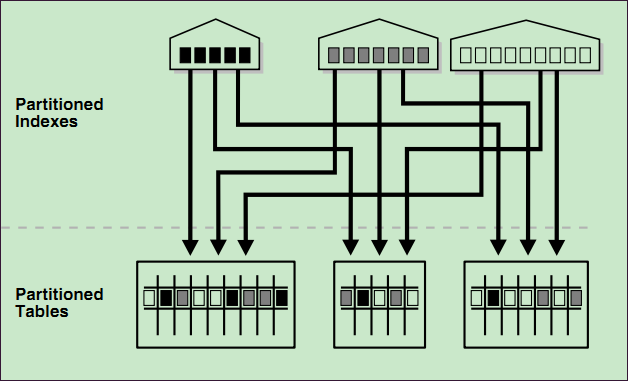更新时间:2025-05-29 GMT+08:00
分区索引
分区表上的索引共有三种类型:
- Global Non-Partitioned Index
- Global Partitioned Index
- Local Partitioned Index
目前GaussDB支持Global Non-Partitioned Index和Local Partitioned Index类型索引。
图1 Global Non-Partitioned Index


图2 Global Partitioned Index


图3 Local Partitioned Index


约束
- 分区表索引分为LOCAL索引与GLOBAL索引:LOCAL索引与某个具体分区绑定,而GLOBAL索引则对应整个分区表。
- 唯一约束和主键约束的约束键包含所有分区键则创建LOCAL索引,否则创建GLOBAL索引。
- 在创建LOCAL索引时,可以通过FOR { partition_name | ( partition_value [, ...] ) }子句,指定在单个分区上创建LOCAL索引,此类索引在其他分区上不生效,后续新增的分区也不会自动创建该索引。需要注意的是,当前仅静态剪枝到单个分区的计划支持生成分类索引的查询路径。

当查询语句在查询数据涉及多个目标分区时,建议使用GLOBAL索引,反之建议使用LOCAL索引。但需要注意GLOBAL索引在分区维护语法中存在额外的开销。
示例
- 创建表
gaussdb=# CREATE TABLE web_returns_p2 ( ca_address_sk INTEGER NOT NULL , ca_address_id CHARACTER(16) NOT NULL , ca_street_number CHARACTER(10) , ca_street_name CHARACTER VARYING(60) , ca_street_type CHARACTER(15) , ca_suite_number CHARACTER(10) , ca_city CHARACTER VARYING(60) , ca_county CHARACTER VARYING(30) , ca_state CHARACTER(2) , ca_zip CHARACTER(10) , ca_country CHARACTER VARYING(20) , ca_gmt_offset NUMERIC(5,2) , ca_location_type CHARACTER(20) ) PARTITION BY RANGE (ca_address_sk) ( PARTITION P1 VALUES LESS THAN(5000), PARTITION P2 VALUES LESS THAN(10000), PARTITION P3 VALUES LESS THAN(15000), PARTITION P4 VALUES LESS THAN(20000), PARTITION P5 VALUES LESS THAN(25000), PARTITION P6 VALUES LESS THAN(30000), PARTITION P7 VALUES LESS THAN(40000), PARTITION P8 VALUES LESS THAN(MAXVALUE) ) ENABLE ROW MOVEMENT; - 创建索引
- 创建分区表LOCAL索引tpcds_web_returns_p2_index1,不指定索引分区的名称。
gaussdb=# CREATE INDEX tpcds_web_returns_p2_index1 ON web_returns_p2 (ca_address_id) LOCAL;当结果显示为如下信息,则表示创建成功。CREATE INDEX
- 创建分区表LOCAL索引tpcds_web_returns_p2_index2,并指定索引分区的名称。
gaussdb=# CREATE TABLESPACE example2 LOCATION '/home/omm/example2'; CREATE TABLESPACE example3 LOCATION '/home/omm/example3'; CREATE TABLESPACE example4 LOCATION '/home/omm/example4'; gaussdb=# CREATE INDEX tpcds_web_returns_p2_index2 ON web_returns_p2 (ca_address_sk) LOCAL ( PARTITION web_returns_p2_P1_index, PARTITION web_returns_p2_P2_index TABLESPACE example3, PARTITION web_returns_p2_P3_index TABLESPACE example4, PARTITION web_returns_p2_P4_index, PARTITION web_returns_p2_P5_index, PARTITION web_returns_p2_P6_index, PARTITION web_returns_p2_P7_index, PARTITION web_returns_p2_P8_index ) TABLESPACE example2;
当结果显示为如下信息,则表示创建成功。CREATE INDEX
- 创建分区表GLOBAL索引tpcds_web_returns_p2_global_index。
gaussdb=# CREATE INDEX tpcds_web_returns_p2_global_index ON web_returns_p2 (ca_street_number) GLOBAL;当结果显示为如下信息,则表示创建成功。CREATE INDEX
- 创建分类分区索引。
指定分区名:
gaussdb=# CREATE INDEX tpcds_web_returns_for_p1 ON web_returns_p2 (ca_address_id) LOCAL(partition ind_part for p1);指定分区键的值:
gaussdb=# CREATE INDEX tpcds_web_returns_for_p2 ON web_returns_p2 (ca_address_id) LOCAL(partition ind_part for (5000));当结果显示为如下信息,则表示创建成功。CREATE INDEX
- 创建分区表LOCAL索引tpcds_web_returns_p2_index1,不指定索引分区的名称。
- 修改索引分区的表空间
- 修改索引分区web_returns_p2_P2_index的表空间为example1。
gaussdb=# ALTER INDEX tpcds_web_returns_p2_index2 MOVE PARTITION web_returns_p2_P2_index TABLESPACE example1;当结果显示为如下信息,则表示修改成功。ALTER INDEX
- 修改索引分区web_returns_p2_P3_index的表空间为example2。
gaussdb=# ALTER INDEX tpcds_web_returns_p2_index2 MOVE PARTITION web_returns_p2_P3_index TABLESPACE example2;当结果显示为如下信息,则表示修改成功。ALTER INDEX
- 修改索引分区web_returns_p2_P2_index的表空间为example1。
- 重命名索引分区
- 执行如下命令对索引分区web_returns_p2_P8_index重命名web_returns_p2_P8_index_new。
gaussdb=# ALTER INDEX tpcds_web_returns_p2_index2 RENAME PARTITION web_returns_p2_P8_index TO web_returns_p2_P8_index_new;当结果显示为如下信息,则表示重命名成功。ALTER INDEX
- 执行如下命令对索引分区web_returns_p2_P8_index重命名web_returns_p2_P8_index_new。
- 查询索引
- 执行如下命令查询系统和用户定义的所有索引。
gaussdb=# SELECT RELNAME FROM PG_CLASS WHERE RELKIND='i' or RELKIND='I'; - 执行如下命令查询指定索引的信息。
gaussdb=# \di+ tpcds_web_returns_p2_index2
- 执行如下命令查询系统和用户定义的所有索引。
- 删除索引
gaussdb=# DROP INDEX tpcds_web_returns_p2_index1;当结果显示为如下信息,则表示删除成功。DROP INDEX
- 清理示例
gaussdb=# DROP TABLE web_returns_p2;
父主题: 分区表查询优化






